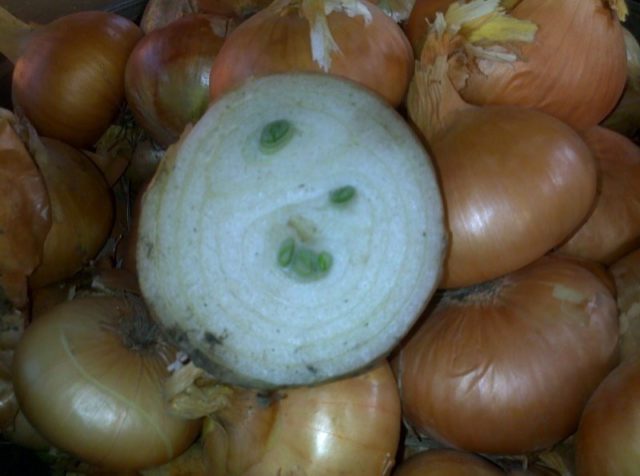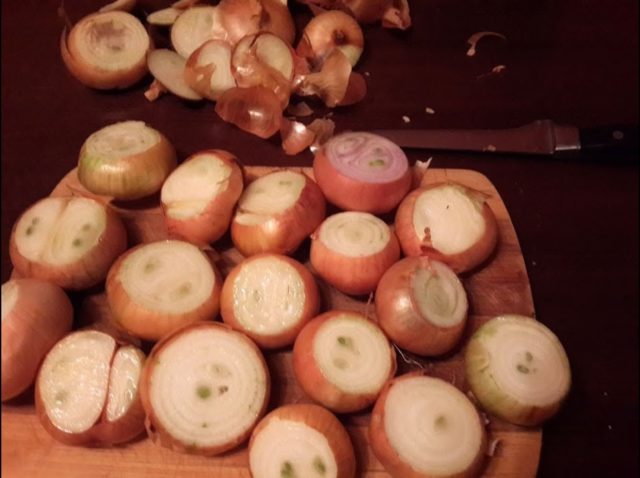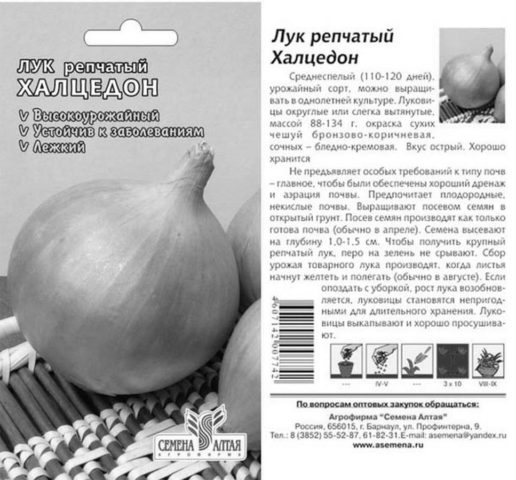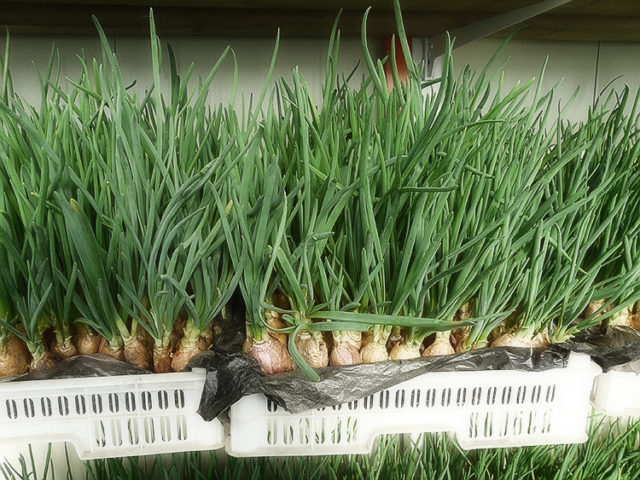Content
- 1 Features of growing onions on a feather in a greenhouse
- 2 The best varieties of green onions for growing in a greenhouse
- 3 When can you plant onions in a greenhouse
- 4 Preparation of soil and planting material
- 5 Planting onions in greenhouses
- 6 How to grow onions for herbs in a greenhouse
- 7 Pests and diseases
- 8 Conclusion
Any fresh greens are especially popular in winter and spring, when the gardens are still covered with snow, and not everyone has heated greenhouses. True, if we talk about forcing onions on a feather, then onion varieties are the least suitable for winter time, since they require more heat and light than their perennial varieties. Planting onions in the greenhouse in spring in a greenhouse is more justified, since it often allows you to do without additional heating and lighting and ultimately get much better results in terms of yield.
Features of growing onions on a feather in a greenhouse
For the normal and fruitful forcing of onions, two basic conditions are vital: temperature and light. Of course, moisture and soil quality also play a role, as well as the quality indicators of seed material, but the latter will be discussed in detail in the next chapter.
Forcing onions on a feather can take place at temperatures from + 8 ° C to + 25 ° C. At the time of landing, it is desirable that the temperature be within + 18-22 ° C. Of course, in the middle lane in the greenhouse, such a temperature can be formed only during the daytime. Additional heating will most likely be required at night. To keep warm at night, it is important to pay attention to the good thermal insulation of the greenhouse. This issue should be taken into account even at the stage of its construction, so as not to save too much on the thickness of the greenhouse coating material.
To simplify your task, it is advisable to use racks or special tables raised above the ground for planting onions on a feather. After all, the air in greenhouses warms up much faster than the soil below and this will reduce heat consumption for heating. In addition, the racks can provide an increase in the planting area, if they are made in two, or even three tiers.
In the first 8-12 days after planting, the onion practically does not need light, and then 12 hour daylight hours are enough for good development. A similar level of lighting may well be provided without installing additional lamps, if the onions are planted no earlier than the beginning of March.
For successful forcing of onions on feathers, the air in the greenhouse should not stagnate, and there should not be too high humidity inside. These factors together have a depressing effect on the growth of greenery and can lead to various unpredictable diseases. To reduce humidity, you can adjust the temperature (lower it). You can use a regular household fan to circulate air, and in warm weather, be sure to ventilate the greenhouse.
Watering onions grown on a feather is vital only at the very beginning of the process, after planting. Then a lot depends on the temperature and conditions that will be in the greenhouse.
The best varieties of green onions for growing in a greenhouse
If the cultivation of feather onions is made one of the means of income, then the choice of the most suitable variety is the basis of the foundations of possible profitability.You should choose from those varieties that will be either multi-nested or multi-primordial. There are several varieties that are most beneficial for forcing on feathers in greenhouses.
Karatalsky
One of the best varieties for growing in greenhouses for feathers, as it is both multi-germ and multi-nest. In addition, he has a very short rest period and is able to wake up early. Having planted it, you can always be confident not only in the quality of the crop, but also in the early terms of its receipt.
Rostov local (Lugansk)
Local Rostov onions also show good results when grown on feathers. It has at least three primordia and is characterized by an average resting period. This variety has another remarkable property - the meatiness of the feather inspiring respect. When planting large bulbs with a diameter of more than 5 cm, the harvest can be more than decent - up to 15-18 kg per 1 sq. m.
Stuttgarter Riesen
Although this onion has a long dormancy period, it is ideal for greenhouse forcing in spring. More than three primordia can always be found in it, and it forms a powerful, beautiful and healthy feather. Plus, it's pretty easy to get hold of. The variety is well-known and is found almost everywhere.
Egyptian
This is a rather conventional name for onions for growing on a feather. Since it is of imported origin, it may not be very easy to get it. But it has many beginnings and grows well.
Chalcedony
Although this onion usually has no more than 2-3 primordia, it is distinguished by its unpretentiousness and good growth, and most importantly, it is found everywhere. It will not be difficult to find its seeds for planting. The varieties Bessonovsky yielding, Danilovsky 301 and Strigunovsky local differ in approximately the same properties.
When can you plant onions in a greenhouse
In the conditions of the middle zone (latitude of the Moscow region), onions for forcing on a feather in a greenhouse hardly makes sense to plant before the beginning of March. Planting earlier will result in lower yields, or higher costs for growing green feathers.
In more southern areas, of course, it is allowed to plant onions on a feather earlier, during February.
Preparation of soil and planting material
Onions on a feather can be planted both on a soil substrate, the basis of which is ordinary garden soil, and on artificially created soil, the basis for which is sawdust. For beginners in this business, it is advisable to use ordinary land, which is in the greenhouse. It should only be mixed in the fall with humus or compost, adding a bucket of these components per 1 sq. m. soil.
You can even grow onions on a feather in boxes placed on the surfaces of the shelves. In this case, the thickness of the earth layer in them is approximately 5-6 cm. If the boxes are sealed or covered with plastic wrap, then it is imperative to provide drainage holes in them to drain excess liquid during watering. Otherwise, the bulbs may simply rot from excess moisture.
The preparation of the onion itself consists of several procedures. To begin with, before planting, the onion must be brought into a warm room for several days and allowed to warm up. After all, onions are usually stored at a temperature of about + 5 ° C so that it does not germinate.
Then the bulbs must be sorted by size. For forcing, you can use bulbs with a diameter of 3 to 8 cm. Larger bulbs may no longer give the expected yield effect from them, and smaller ones will form too thin and weak feathers.
It is best to keep the bulbs of about the same size in the drawer. In this case, germination will be more uniform. To speed up the process, as well as for a more beautiful and even germination of the feather, the necks of each bulb are cut off, leaving about ¾ of the bulb itself.
Equally important is the soaking procedure.In extreme cases, you can do without it, but it significantly speeds up the germination process and, most importantly, disinfects the planting material. Usually onions are soaked directly in bags in warm water with a temperature of + 50 ° C with the addition of potassium permanganate.
Planting onions in greenhouses
Planting onions on a feather in greenhouses can theoretically be carried out both with the help of ready-made bulbs and with seeds - the so-called nigella.
Seeds
This method is incredibly laborious and time-consuming. Therefore, it is suitable only for those who do not have the funds at all to buy ready-made bulbs for planting in the right amount, but have a lot of free time and a desire to tinker with onion seedlings.
In this case, usually in the spring, seeds of a suitable variety of black onions are sown in boxes and they take care of the seedlings for a whole year until next spring. In the summer they are seated more freely so that by late autumn they can turn into bulbs of more or less decent sizes. Then they are dug up and stored in a cold place until spring to be planted in the usual way, which will be described below.
Bulbs
When growing feathers from bulbs in greenhouses, the bridge planting method is most often used. In this case, 1 sq. m. usually spend about 25-30 kg of ready-made bulbs. This amount is approximately one standard mesh bag of onions.
How to plant onion sets on greens in a greenhouse
With the bridge method, pre-prepared bulbs are planted almost on the surface of the earth with a cut upward, deepening them by only 1 cm. Moreover, the planting density should be such that almost all bulbs are in contact with all their parts with each other. From the bulbs, figuratively speaking, the bridge is lined, hence the name of this planting method. Thus, a large amount of space is saved, which is especially important for small areas in compact greenhouses.
When first landing, it can take quite a long time. With the acquisition of experience in landing 1 sq. m. in this way should take no more than 30 minutes for one person.
How to grow onions for herbs in a greenhouse
In the process of caring for a growing green feather, no particular difficulties are observed. Rooting of the bulbs usually takes place within the first 10 days. Then the first green shoots appear. During this period, by changing the temperature, it is possible to regulate the intensity of onion growth. For example, if before the holidays it is necessary to "keep it in growth" a little, then the temperature is lowered, but so that it drops not below + 8 ° С. On the contrary, when the temperature rises, the growth rate of the feather is significantly accelerated. But even here there is a limit. When the temperature rises above + 25 ° C, the tips of the leaves may begin to dry on the onion, which has a bad effect on the presentation of the vegetable.
Watering
Watering is necessary only when growing green onions in rather warm conditions, when the land has clear signs of drying out. It can be carried out both from a hose and from a watering can. The temperature of the water does not really matter, but it is still better to use settled water, not ice water.
Weeding and loosening
There is no need for weeding and loosening, since the bulbs occupy absolutely the entire area of the soil. But a periodic sampling of bulbs affected by diseases or starting to rot is simply necessary.
Top dressing
Usually, if the onion for the feather was planted in soil fertilized with humus in the fall, then it does not need any additional feeding. But periodic spraying with Fitosporin will allow for the prevention of possible diseases and save most of the healthy bulbs from possible infection.
Harvesting
In general, the length of the leaves is a sign of the readiness of onion greens for harvesting. It should reach at least 25-30 cm. But it is better to wait for the length of onion feathers from 40 to 50 cm.This will allow you to get the maximum yield of greens by weight.
Typically, in the spring, the period from planting to harvest is about 30 days on average. It can vary from 20 to 40 days.
The very process of harvesting is that with a sharp knife the onion is cut at the root along the very surface of the substrate. Then a cut is made at the very bottom of the bulb. The bulb is pulled together, and the clean and dense green of the feather remains in the hands. Its white part is cleaned of slippery film and put into a prepared box. Each onion is treated in the same way. The old onion is thrown onto the compost heap.
It should be noted that the average yield is 25 to 65% of the weight of the original bulbs. That is, if 100 kg of onions were planted, then you can get from 25 to 65 kg of green onions. Productivity is most of all determined by the number of buds in the variety used. Thus, from one square meter in a greenhouse, you can get from 8 to 20 kg of early green onions.
Pests and diseases
An invasion of pests or diseases is much easier to prevent than to cure. And this statement is more than true in relation to the cultivation of onions on a feather. Since it only lasts about a month, no treatment makes sense here. It is only necessary:
- sort the bulbs very carefully before planting;
- carry out the disinfection procedure before planting;
- use Fitosporin regularly;
- periodically inspect the plantings and remove any bulbs starting to deteriorate;
- ventilate the greenhouse regularly and use a fan to circulate the air.
Conclusion
Planting onions on greens in a greenhouse in spring can be an effective aid in vitaminizing a family. And also she is able to serve as a good auxiliary income. And if everything works out and the goods are in demand, then you can, if you wish, expand the sown area and take this business seriously.

















